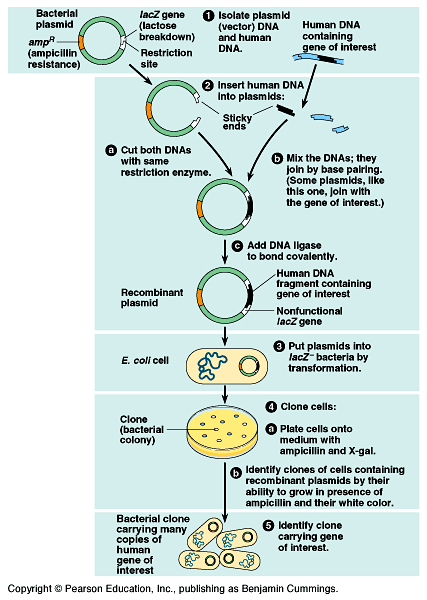Describe how molecular cloning gene cloning is used to produce multiple copies of a DNA fragment. A fragment of DNA containing a gene of interest is isolated inserted into the plasmid and transformed using a suitable bacterial host.

17 1c Molecular And Cellular Cloning Biology Libretexts
The pioneering work in the early 1970s using DNA ligases to paste DNA into episomal vectors is still the most widely used approach.

. Table 8-7 Some Major Steps in the Development of Recombinant DNA and Transgenic Technology. Annealing - the two primers bind the appropriate complementary strand. The cloning of humans remains universally condemned primarily for the associated psychological social and physiological risks.
The egg is then stimulated to. Describe the natural mechanisms for producing recombinant DNA in prokaryotes. Single-celled organisms like bacteria make exact copies of themselves each time they reproduce.
In practice localisation of the gene does not always enable one to amplify the relevant genomic sequence. TOPO TA Cloning TOPO cloning uses a single enzyme Topoisomerase I TI to both unwind and ligate DNA. Two types of enzymes are used in this method.
List and compare at. Central to the technology are the following key techniques. This is known as a recombinant plasmid.
Genes cells tissues and even whole animals can all be cloned. The approach to producing an artificially cloned individual is to take the egg cell of one individual and to remove the haploid nucleus. The temperature for this step varies depending on the of size of.
The cloning of foreign DNA in Escherichia coli episomes is a cornerstone of molecular biology. DNA extracted from an organism known to have the gene of interest is cut into gene-size pieces with restriction enzymes. Cloning of any DNA sequence involves the following four steps.
Then a diploid nucleus from a body cell of a second individual the donor is put into the egg cell. DNA Cloning takes place in the following steps. Be sure to explain the role of vectors in this process.
Cloning is a technique scientists use to make exact genetic copies of living things. We understand that every molecular cloning project is unique and we offer a variety of high quality reagents and kits for every step of your molecular cloning workflow. The steps involve heating the template DNA in order to denature or separate the strands dropping the temperature to allow the primers to anneal and then heating the mixture up to allow the DNA polymerase to extend the primers using the original DNA as an initial template.
Coli recover the plasmid DNA and check for correct insertion events. The restriction enzymes cut the DNA at specific target sequences. In humans identical twins are similar to clones.
The target gene is inserted into the cut site and is ligated by DNA ligase. Bacterial plasmids are cut with the same restriction enzyme. Cleavage of DNAat specific sites by restriction nucleases which greatly facilitates the isolation and manipulation of.
TI is used in the natural process of replication. The piece of DNA is pasted into a vector and the ends of the DNA are joined with the vector DNA by ligation. Cut open the plasmid and paste in the gene.
The openingunwinding of DNA creates pressure further upstream so to relieve this stress and prevent breakage TI binds to DNA cleaves and unwinds it then re-joins the nick just created. To get the DNA fragment into a bacterial cell in a form that will be copied or expressed the fragment is first inserted into a plasmid. Gene cloning is a simple yet complicated and highly sophisticated technique.
The basic steps in gene cloning are. The vector is introduced into a host cell often a bacterium or yeast by a process called transformation. There are also concerns that cloning promotes eugenics the idea that humanity could be improved through the selection of individuals possessing desired traitsThere also exists controversy over the ethics of therapeutic and.
Here we sequentially explain PCR cloning from the analysis of the respective gene sequence the design of PCR primers performing the PCR procedure itself sequencing the resulting PCR products analysis of sequencing data and finally the cloning of the PCR product into the final vector. A plasmid also called a vector in this context is a small circular DNA molecule that replicates independently of the. The chosen piece of DNA is cut from the source organism using restriction enzymes.
Denaturation - the DNA is heated usually to 95 o C to render it single-stranded. This process relies on restriction enzymes which cut DNA and DNA ligase which joins DNA. This protocol describes the basic steps involved in conventional plasmid-based cloning.
In nature what are the 2 basic steps involved in producing recombinant DNA. Here we describe a different principle using ET recombination for dir. Our restriction enzymes high performance DNA polymerases DNA modifying enzymes and ligation kits provide all of the tools necessary for the.
Some clones already exist in nature. The Gene of interest is isolated at the end of the experiment using the antibiotic resistance gene. Steps and procedure.
Cutting and Pasting DNA. The three steps of the reaction are. Insert the plasmid into bacteria.
Use antibiotic selection to identify the bacteria that took up the plasmid. Cloning allows for the creation of multiple copies of genes expression of genes and study of specific genes. The gene-sized DNA and cut plasmids are combined into one test tube.
The basic steps are. The goals are to insert a DNA fragment of interest into a receiving vector plasmid transform the plasmid into E.

Gene Cloning Steps Involved In Gene Cloning Online Biology Notes

Dna Cloning Process Steps Examples What Is Dna Cloning Video Lesson Transcript Study Com

0 Comments